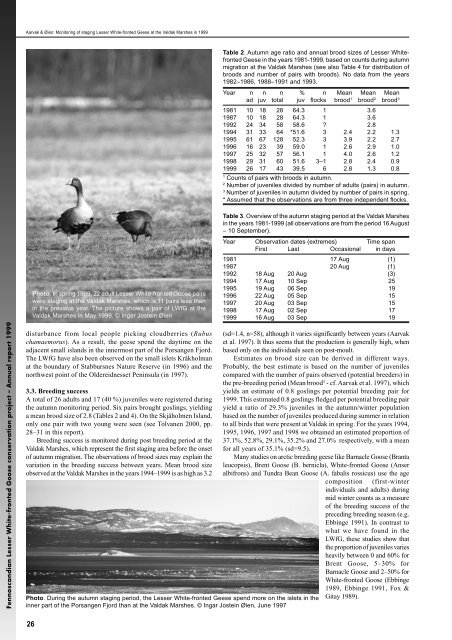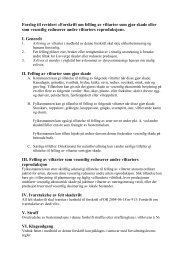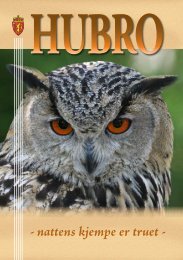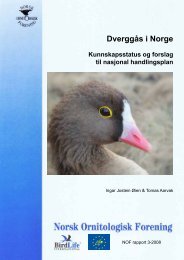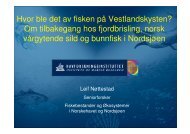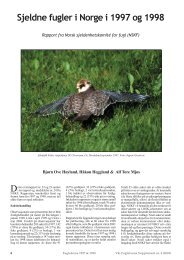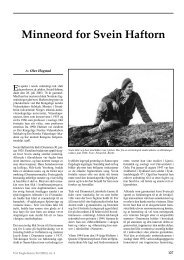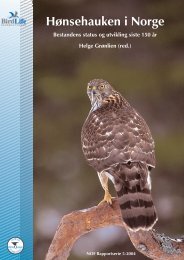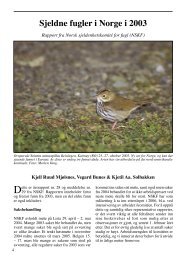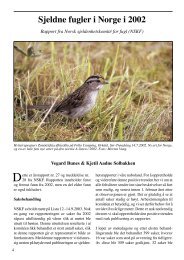Fennoscandian Lesser White-fronted Goose conservation project ...
Fennoscandian Lesser White-fronted Goose conservation project ...
Fennoscandian Lesser White-fronted Goose conservation project ...
Create successful ePaper yourself
Turn your PDF publications into a flip-book with our unique Google optimized e-Paper software.
<strong>Fennoscandian</strong> <strong>Lesser</strong> <strong>White</strong>-<strong>fronted</strong> <strong>Goose</strong> <strong>conservation</strong> <strong>project</strong> – Annual report 1999<br />
Aarvak & Øien: Monitoring of staging <strong>Lesser</strong> <strong>White</strong>-<strong>fronted</strong> Geese at the Valdak Marshes in 1999<br />
disturbance from local people picking cloudberries (Rubus<br />
chamaemorus). As a result, the geese spend the daytime on the<br />
adjacent small islands in the innermost part of the Porsangen Fjord.<br />
The LWfG have also been observed on the small islets Kråkholman<br />
at the boundary of Stabbursnes Nature Reserve (in 1996) and the<br />
northwest point of the Oldereidnesset Peninsula (in 1997).<br />
3.3. Breeding success<br />
A total of 26 adults and 17 (40 %) juveniles were registered during<br />
the autumn monitoring period. Six pairs brought goslings, yielding<br />
a mean brood size of 2.8 (Tables 2 and 4). On the Skjåholmen Island,<br />
only one pair with two young were seen (see Tolvanen 2000, pp.<br />
28–31 in this report).<br />
Breeding success is monitored during post breeding period at the<br />
Valdak Marshes, which represent the first staging area before the onset<br />
of autumn migration. The observations of brood sizes may explain the<br />
variation in the breeding success between years. Mean brood size<br />
observed at the Valdak Marshes in the years 1994–1999 is as high as 3.2<br />
26<br />
Photo. In spring 1999, 22 adult <strong>Lesser</strong> <strong>White</strong>-<strong>fronted</strong> <strong>Goose</strong> pairs<br />
were staging at the Valdak Marshes, which is 11 pairs less than<br />
in the previous year. The picture shows a pair of LWfG at the<br />
Valdak Marshes in May 1999. © Ingar Jostein Øien<br />
Table 2. Autumn age ratio and annual brood sizes of <strong>Lesser</strong> <strong>White</strong><strong>fronted</strong><br />
Geese in the years 1981-1999, based on counts during autumn<br />
migration at the Valdak Marshes (see also Table 4 for distribution of<br />
broods and number of pairs with broods). No data from the years<br />
1982–1986, 1988–1991 and 1993.<br />
Year n n n % n Mean Mean Mean<br />
ad juv total juv flocks brood1 brood2 brood3 1981 10 18 28 64.3 1 3.6<br />
1987 10 18 28 64.3 1 3.6<br />
1992 24 34 58 58.6 ? 2.8<br />
1994 31 33 64 *51.6 3 2.4 2.2 1.3<br />
1995 61 67 128 52.3 3 3.9 2.2 2.7<br />
1996 16 23 39 59.0 1 2.6 2.9 1.0<br />
1997 25 32 57 56.1 1 4.0 2.6 1.2<br />
1998 29 31 60 51.6 3–1 2.8 2.4 0.9<br />
1999 26 17 43 39.5 6 2.8 1.3 0.8<br />
1 Counts of pairs with broods in autumn.<br />
2 Number of juveniles divided by number of adults (pairs) in autumn.<br />
3 Number of juveniles in autumn divided by number of pairs in spring.<br />
* Assumed that the observations are from three independent flocks.<br />
Table 3. Overview of the autumn staging period at the Valdak Marshes<br />
in the years 1981-1999 (all observations are from the period 16 August<br />
– 10 September).<br />
Year Observation dates (extremes) Time span<br />
First Last Occasional in days<br />
1981 17 Aug (1)<br />
1987 20 Aug (1)<br />
1992 18 Aug 20 Aug (3)<br />
1994 17 Aug 10 Sep 25<br />
1995 19 Aug 06 Sep 19<br />
1996 22 Aug 05 Sep 15<br />
1997 20 Aug 03 Sep 15<br />
1998 17 Aug 02 Sep 17<br />
1999 16 Aug 03 Sep 19<br />
(sd=1.4, n=58), although it varies significantly between years (Aarvak<br />
et al. 1997). It thus seems that the production is generally high, when<br />
based only on the individuals seen on post-moult.<br />
Estimates on brood size can be derived in different ways.<br />
Probably, the best estimate is based on the number of juveniles<br />
compared with the number of pairs observed (potential breeders) in<br />
the pre-breeding period (Mean brood 3 - cf. Aarvak et al. 1997), which<br />
yields an estimate of 0.8 goslings per potential breeding pair for<br />
1999. This estimated 0.8 goslings fledged per potential breeding pair<br />
yield a ratio of 29.3% juveniles in the autumn/winter population<br />
based on the number of juveniles produced during summer in relation<br />
to all birds that were present at Valdak in spring. For the years 1994,<br />
1995, 1996, 1997 and 1998 we obtained an estimated proportion of<br />
37.1%, 52.8%, 29.1%, 35.2% and 27.0% respectively, with a mean<br />
for all years of 35.1% (sd=9.5).<br />
Many studies on arctic breeding geese like Barnacle <strong>Goose</strong> (Branta<br />
leucopsis), Brent <strong>Goose</strong> (B. bernicla), <strong>White</strong>-<strong>fronted</strong> <strong>Goose</strong> (Anser<br />
albifrons) and Tundra Bean <strong>Goose</strong> (A. fabalis rossicus) use the age<br />
composition (first-winter<br />
individuals and adults) during<br />
mid winter counts as a measure<br />
of the breeding success of the<br />
preceding breeding season (e.g.<br />
Ebbinge 1991). In contrast to<br />
what we have found in the<br />
LWfG, these studies show that<br />
the proportion of juveniles varies<br />
heavily between 0 and 60% for<br />
Brent <strong>Goose</strong>, 5–30% for<br />
Barnacle <strong>Goose</strong> and 2–50% for<br />
<strong>White</strong>-<strong>fronted</strong> <strong>Goose</strong> (Ebbinge<br />
1989, Ebbinge 1991, Fox &<br />
Photo. During the autumn staging period, the <strong>Lesser</strong> <strong>White</strong>-<strong>fronted</strong> Geese spend more on the islets in the<br />
inner part of the Porsangen Fjord than at the Valdak Marshes. © Ingar Jostein Øien, June 1997<br />
Gitay 1989).


